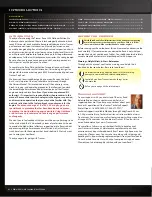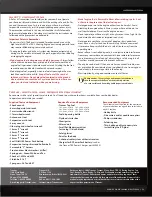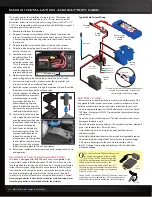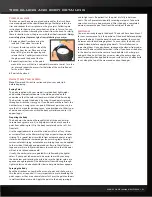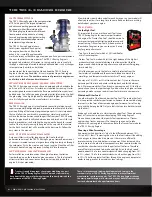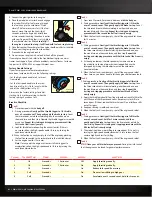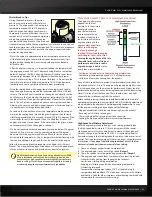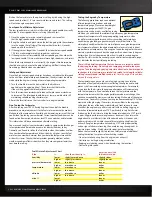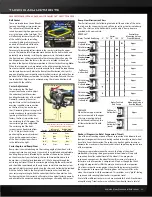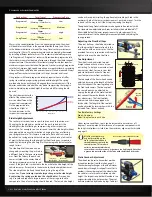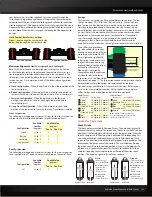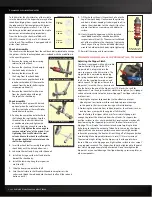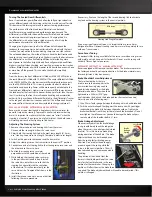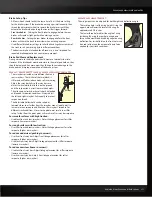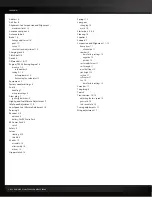
10 • REVO PLATINUM EDITION
Richen the fuel mixture to the optimum setting by richening the high-
speed needle at least 1/8 turn counterclockwise and retest. This setting
will extend engine component life.
Low-Speed Fuel Mixture Adjustment
The low-speed mixture is always set after the high-speed needle is correctly
adjusted. The low-speed mixture is set using the pinch test.
1.
Once the engine is warm, do several high-speed runs to confirm
that the high-speed needle is set correctly.
2.
Bring the vehicle in and pinch closed the fuel line going into the carburetor
(use the engine shut-off clamp). The engine should run for 2-3 seconds,
speed up, and then shut off.
3.
If the engine runs longer than 3 seconds, then lean the low-speed needle
1/16 turn, make several more high-speed runs, and retest.
4.
If the engine shuts off immediately without speeding up, then richen the
low-speed needle 1/8 turn, make several more high-speed runs, and retest.
When the low-speed needle is set correctly, the engine’s throttle response
should be very quick, even to the point of making it difficult to keep Revo
from doing a wheelie when you accelerate!
Idle Speed Adjustment
Once the high and low-speed mixtures have been set, reduce the idle speed
to the minimum reliable idle speed. Remember, this adjustment should be
made while the engine is running at normal operating temperature.
1.
Turn the throttle trim on the transmitter so the brakes are
applied (note its original position). This ensures that the throttle
slide is resting against the idle adjustment screw.
2.
Turn the screw counterclockwise to reduce the idle speed, or clockwise
to increase it. The idle speed should be set as low as possible while still
maintaining reliable running characteristics.
3.
Reset the throttle trim on the transmitter to its original position.
Fine-Tuning the Carburetor
After fine-tuning your TRX 3.3 Racing Engine at the end of the break-in
procedure, no major adjustments to the fuel mixture are usually necessary.
Make note of the temperature, humidity, and barometric pressure at the time
you finished fine tuning your carburetor. Current weather conditions can be
found online from national websites, local TV news websites, and television.
This information will be considered your baseline setting.
You may need to adjust your carburetor needles to compensate for changes
in temperature and barometric pressure (air density) from day to day.
Generally, you’ll need to richen the fuel mixture when the weather is colder
than your baseline temperature and the air density is higher. Lean the fuel
mixture when weather is warmer than your baseline temperature and the
air density is lower. The chart below provides general guidelines on how
weather conditions affect air density when they move higher or lower than
your baseline setting.
Tuning the Engine by Temperature
The following procedures require an optional
infrared temperature probe or on-board
temperature gauge (Traxxas on-board digital
temperature gauge, part #4091). Engine
temperature can be used as an effective tuning
aid when you understand the relationship between engine temperature
and ambient temperature. The engine operating temperature, when
tuned for maximum performance, will vary according to atmospheric
conditions, engine load, gauge accuracy, and many other factors. The
atmospheric condition that has the most influence on engine temperature
is air temperature. Expect the engine temperature to vary almost in direct
proportion to air temperature. Assuming you tuned the engine for the same
maximum performance each day, the engine will run about twenty degrees
hotter when it’s ninety degrees outside than it would in seventy-degree
weather. For this reason, we cannot give you a definitive temperature range
that indicates the best possible engine tuning.
There is NO optimal temperature that can be used as a target to deliver
the best engine tuning. Do not rely on a temp gauge alone to tune your
engine. Tune the engine by paying very close attention to how it responds
to changes in fuel mixture (more smoke/less smoke, fast/sluggish, reliable/
stalling, smooth sound/ muffled sound, etc)
. Once the engine is tuned, then
observe the temperature.
The temperature gauge can aid you in tuning by giving you a relative
indication of how your adjustments are affecting the engine and to help
prevent you from reaching excessive engine temperatures. For example,
as you lean the fuel mixture, the engine performance will increase along
with the temperature. If you continue to lean the fuel mixture and the
temperature increases but the engine performance does not change, then
you have exceeded the maximum safe lean setting. Make note of the engine
temperature. Generally, try to keep your engine from exceeding 270°F when
measured at the glow plug. If necessary, increase airflow to the engine by
cutting out the rear of the body, windshield, and front valance. In some
situations, the engine may perform very well with no stalling, lagging, or
hesitation at temperatures above 270°F, particularly in very hot climates.
If richening the fuel mixture to bring the temperature down to 270°F results
in poor, sluggish performance (engine never cleans out) then return the
engine back to a satisfactory state of tune based on how it sounds and
performs (always with a visible stream of blue smoke coming from the
exhaust) . If engine temperature is exceeding 270°F with proper cooling
and no signs of abnormal running, then avoid running the engine at its
maximum lean setting. Watch closely for
any
signs of overheating.
Richen the fuel mixture slightly to provide a safety margin of additional
cooling lubrication. Symptoms of overheating include:
• Steam or smoke coming from the engine (not exhaust).
• Hesitation or stalling during acceleration.
• Popping or clattering sound when decelerating (detonation).
• Fluctuating idle speed.
Fuel Mixture Adjustment Chart
adjust (correct) the
fuel mixture to be...
If the...
is...
then the air density is...
humidity
lower
slightly more dense
slightly richer
higher
slightly less dense
slightly leaner
pressure (barometer)
lower
less dense
leaner
higher
more dense
richer
temperature
lower
more dense
richer
higher
less dense
leaner
altitude
lower
more dense
richer
higher
less dense
leaner
nitro %
lower
-
leaner
higher
-
richer
THE TRX 3.3 RACING ENGINE
5304 Manual Work.indd 10
3/12/08 7:47:34 PM


